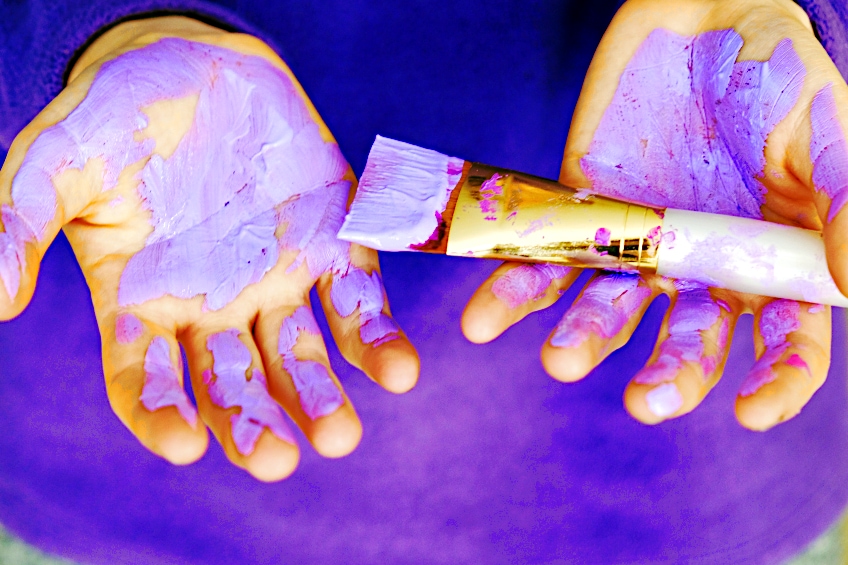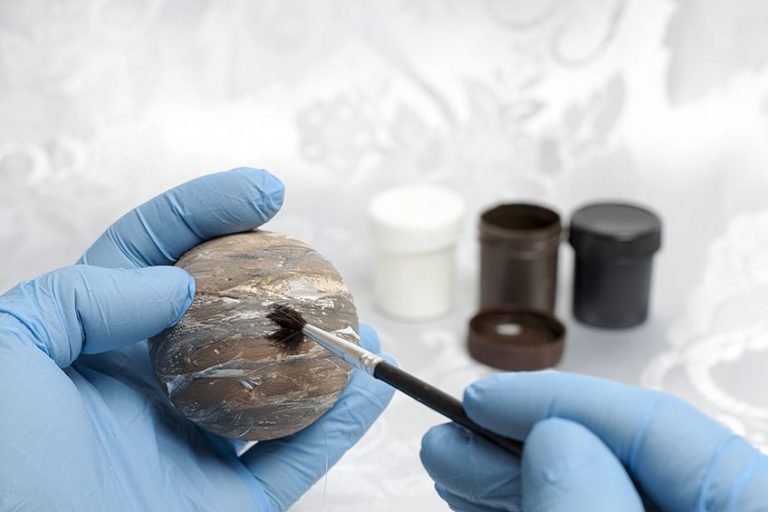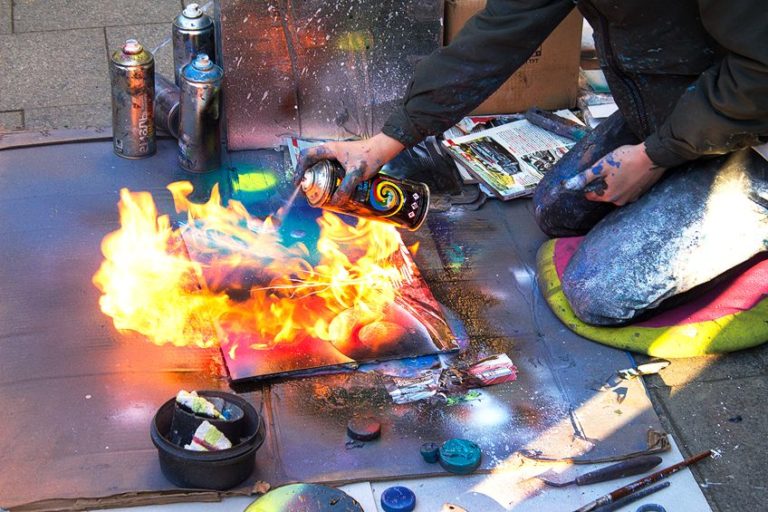Is Acrylic Paint Safe for Skin? – The Toxicity of Acrylic Paints
This post may contain affiliate links. We may earn a small commission from purchases made through them, at no additional cost to you.
Acrylic paint is a medium that is loved by many artists around the world. It has many factors that make it a fantastic choice for all styles of painting, but can you put acrylic paint on your face? Is acrylic paint safe for skin? Does acrylic paint wash off skin? Lots of people like painting patterns on their skin, whether it’s their face, arms, legs, or chest. Many people apply paint to their skin in this way for music festivals, performance art, or as a fun activity at a child’s party, so you might be wondering how to make skin color with acrylic paint. In this article, we explain why acrylic paint isn’t a good choice for anyone looking for paint that is safe on skin.
Table of Contents
What Is Acrylic Paint?
Acrylic is a plastic derivative made from methyl methacrylate (MMA). MMA is colorless, weather-resistant, and does not yellow when exposed to sunlight. Acrylic paint is made from combining a pigment with an acrylic polymer emulsion. Acrylic polymer can be dissolved by water, which in turn makes acrylic paint water-soluble. It is also non-toxic and easy to manufacture, which makes it a great choice for paint manufacturers.
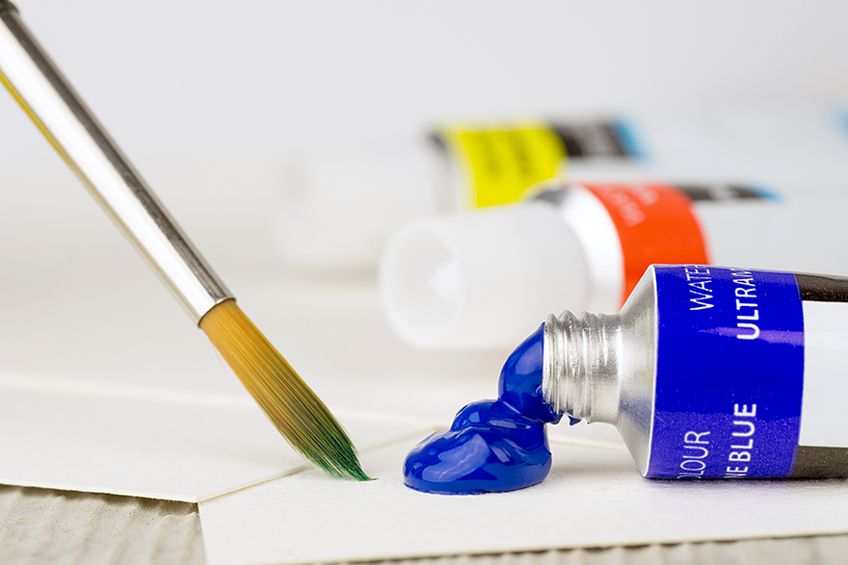
What Qualities Make Acrylic Paint a Good Choice for Artists?
There are many reasons that people choose to use acrylic paints. Some of these reasons include water-solubility, durability, and a fast drying time. We talk about these and other qualities of acrylic paint in more detail below.
Fast Drying Time
Acrylic paint is most well-known for its very fast drying time. When using acrylic paint, you don’t need to worry about waiting a long time for your paint to dry between coats. If the conditions are favorable, acrylic paint can dry completely in about an hour. The fast drying time of acrylic makes it great for layering but can become an issue when it comes to blending.

Water-Soluble and Fume-Free
Acrylic paints are water-soluble while wet, which means that brushes and surfaces can be cleaned using water. Dry acrylic paint may require abrasion and some soap to be properly lifted and cleaned off of surfaces. Acrylic paint is free of toxic odors, meaning that masks are optional for people who do not have sensitivities to fumes. You should always, however, work with paints in a well-ventilated room.

Durable and Versatile
You can use acrylic paint on any porous surface with ease. Smooth, non-porous surfaces can also accept acrylic paint but they may need to be coated with a primer to achieve optimal results. This means that acrylic can essentially be used on canvas, glass, plastic, wood, fabric, ceramic, or just about anything else you can think of. Acrylic paint dries to form a durable, water-resistant film.

What Dangerous Ingredients Can Be Found in Acrylic Paint?
Acrylic paint is quite safe in general and most modern acrylics will be labeled as non-toxic. There are some acrylic paints, however, that may contain some harmful ingredients. We recommend always reading the label of paints as well as any instructions or precautions provided by the manufacturer. This will help you to familiarize yourself with any risks you may encounter while working with your paint.
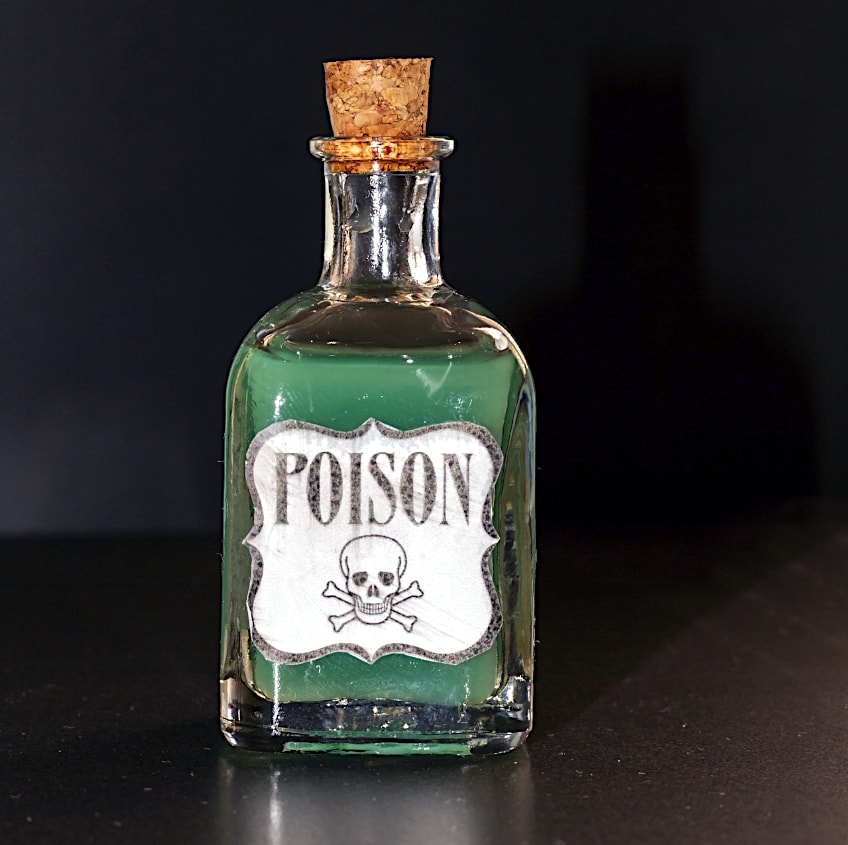
If you are worried about getting acrylic paint on your skin, you should keep an eye out for these five harmful ingredients before you try them out. Most of these ingredients only become toxic when sanded, airbrushed, or ingested in large amounts but you should avoid getting them on your skin too. Paints that contain any of these ingredients will be clearly labeled and should be very easy to spot.
Lead
Lead can be found in some paints and can pose health risks when ingested or inhaled. Exposure to lead can cause anemia, weakness, kidney damage, and brain damage. So while lead doesn’t pose a risk to people when placed on the skin, the flakes that could come off once the paint dries could be dangerous if inhaled.
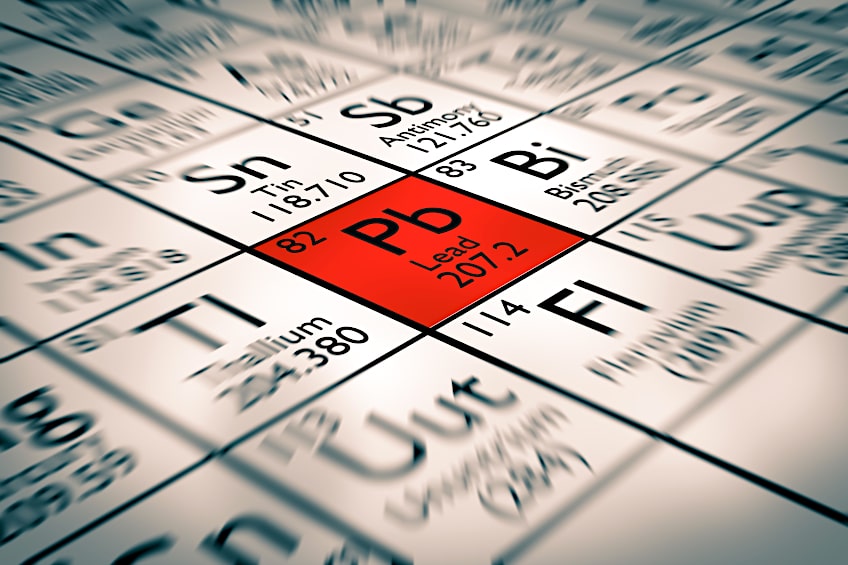
Cobalt
Cobalt is a magnetic material that was used in all sorts of arts in the past, including pottery, porcelain, glass, and more. This was all before it was discovered to be toxic. Cobalt has dangerous effects on the heart, liver, kidneys, and thyroid. It can also cause harm to the eyes, skin, heart, and lungs and may contribute towards increasing cancer risk in mammals. Cobalt can enter your body via inhalation, ingestion, or by being absorbed through your skin.
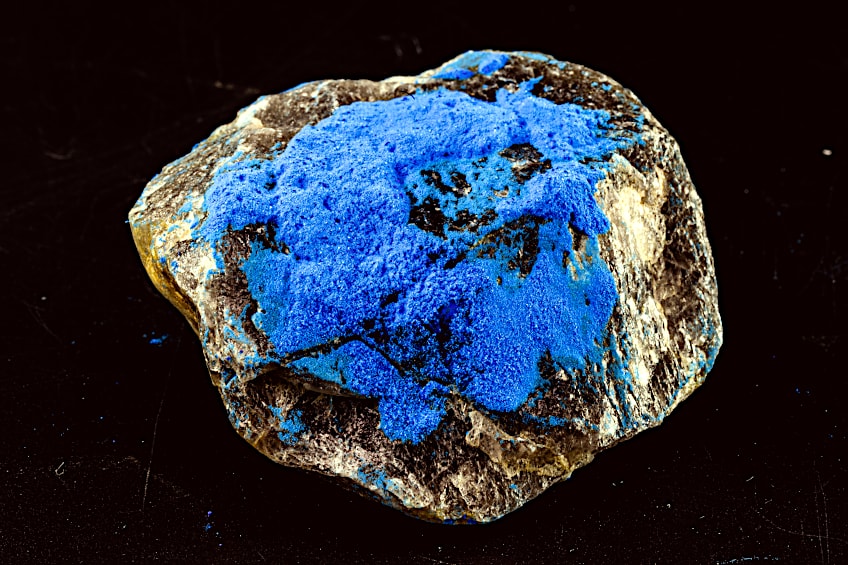
Cadmium
Although it is quite rare, some paints may contain cadmium. Cadmium is a known carcinogenic that attacks every system in your body. Due to these serious health risks, you will be hard-pressed to find many modern paints that contain cadmium. While most cadmium exposure isn’t caused by being absorbed through the skin, it’s a good idea to use a mask and gloves while using paints that contain cadmium. Be sure to work in a well-ventilated room and keep the completed painting behind a glass frame. Be extra careful to not get this paint on your furniture and if you do make a mess, be sure to clean it up as soon as possible.
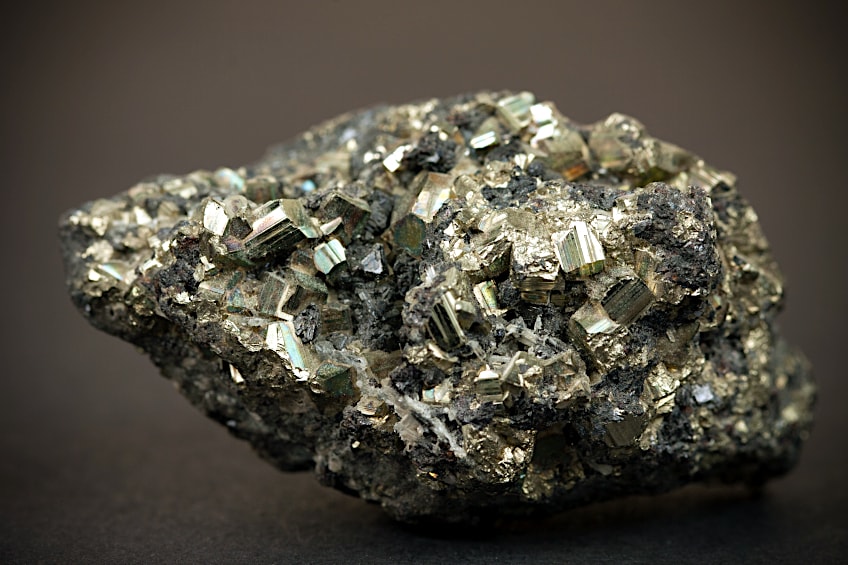
Manganese
Manganese is found in trace amounts in nuts and leafy vegetables. It is healthy in moderation when consumed in its natural form through food, but becomes toxic when inhaled or ingested in other forms. Manganese can also be readily absorbed through the skin. It is usually used in paint as a binder and to help with adhesion, but other paints adhere just fine without the presence of manganese. Manganese can cause lung, liver, vascular, and nerve damage. It can also cause tremors, developmental problems, declines in blood pressure, and issues with coordination.

Chromium
Much like manganese, chromium is actually beneficial to humans in a specific form and amount, however, contact with too much chromium of any kind will cause severe rashes, nosebleeds, and ulcers. Long-term effects of chromium exposure include a weakened immune system as well as kidney and liver damage. Chromium is toxic when inhaled, ingested, or absorbed through skin, which means it is another ingredient that should best be avoided when browsing and purchasing acrylic paints.

Is Acrylic Paint Safe for Skin?
You are now familiar with ingredients found in some acrylic paints, which will make them toxic. Most modern paints will not have those ingredients, and if they do, they will be clearly labeled as such. So, if it’s labeled as non-toxic, is acrylic paint safe for skin? Not really. Can you put acrylic paint on your face? Definitely not.
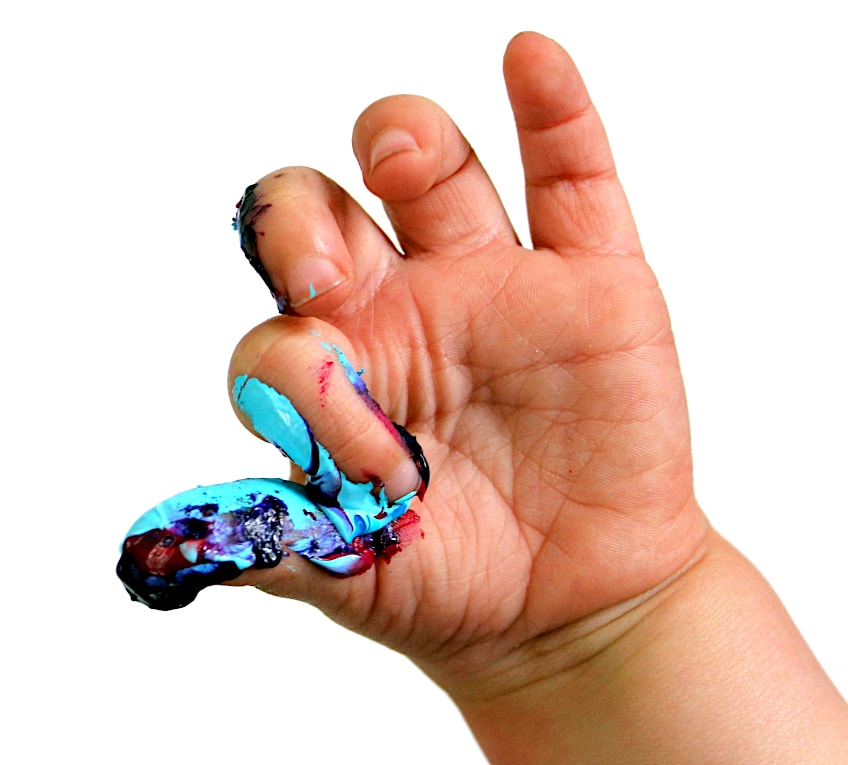
Overall, it is best to not use acrylic paint on your skin if it can be avoided. As it stands there is no definitive clinical trial that shows the long-term effects of absorbing trace amounts of chemicals via skin contact with acrylic paint, but it has been suggested that small exposures over a long amount of time could have unforeseen effects on our health. It is much better to err on the side of caution and avoid using acrylic paint as body paint until there is a definitive answer regarding its safety.

When something is non-toxic, it doesn’t necessarily mean that it is safe. Acrylic paint does not have any pharmaceutical-grade ingredients that would make it safe for use on skin in the same way that makeup would be. Acrylic paint can still cause allergic reactions and rashes when painted directly on to skin, even if it is labeled as non-toxic. The areas around the face and neck will be more reactive to acrylic paint than the rest of the body and should be especially avoided. Children and people with skin conditions such as eczema will also be particularly sensitive to the use of acrylic paint on their skin. Allergic reactions can develop at random, and even people who have never had a problem may suddenly break out in hives when exposed to a previously harmless substance.
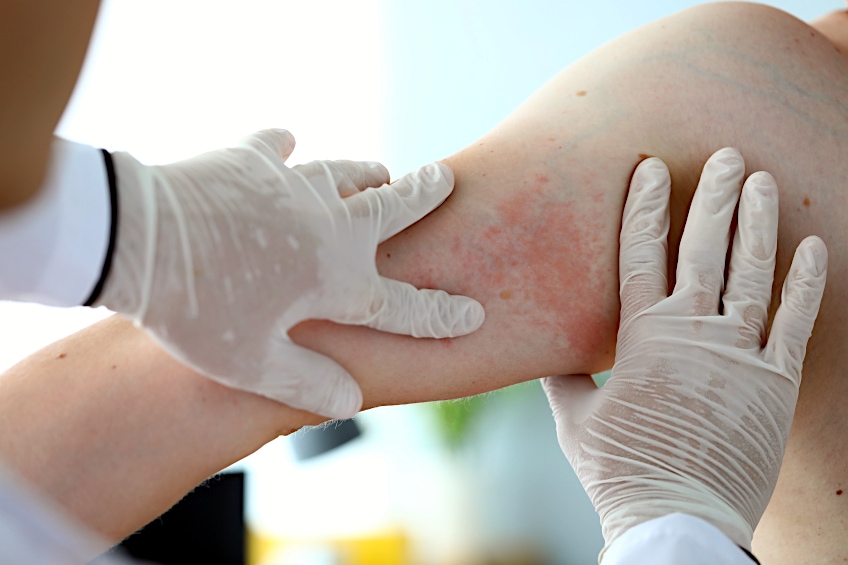
Even though acrylic paint is water-soluble, it can be tricky to wash off properly once an allergic reaction starts. If the paint is left to dry then peeling it off can be quite painful as it will pull the small hairs from your skin. Dried paint can also cause rashes and irritation, and the dust or flakes can be inhaled and cause allergies or enter the eyes and cause damage.
How to Remove Acrylic Paint From Skin
Does acrylic paint wash off skin? Yes, acrylic paint is water-soluble and, for the most part, is easy to clean off of skin and other surfaces. If the paint is still wet, all you will need to remove wet paint is some warm, soapy water and a cloth. Lightly scrub the area with the cloth in circular motions until the area is free of paint. Make sure that you rinse the area of skin thoroughly once you are done.
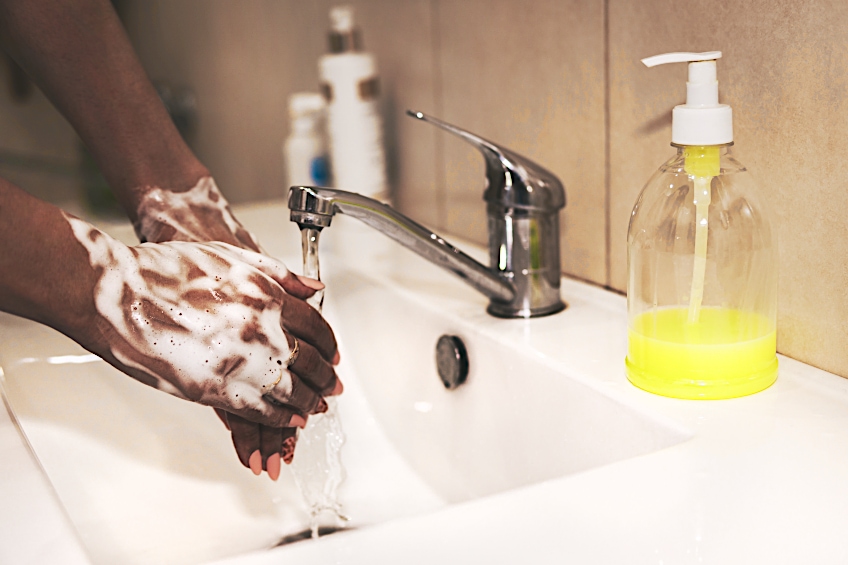
If the acrylic paint has dried you should leave the skin to soak in warm, soapy water until the paint loosens up. You can then lightly scrub the area with a damp cloth until it is free of paint. If this method pulls your skin/hair too much or is not lifting enough paint then you could try applying baby oil to the dried paint. The more baby oil that you rub into the area, the more paint will become suspended in the oil and loosen up. Eventually, you should be able to wipe off the paint completely.
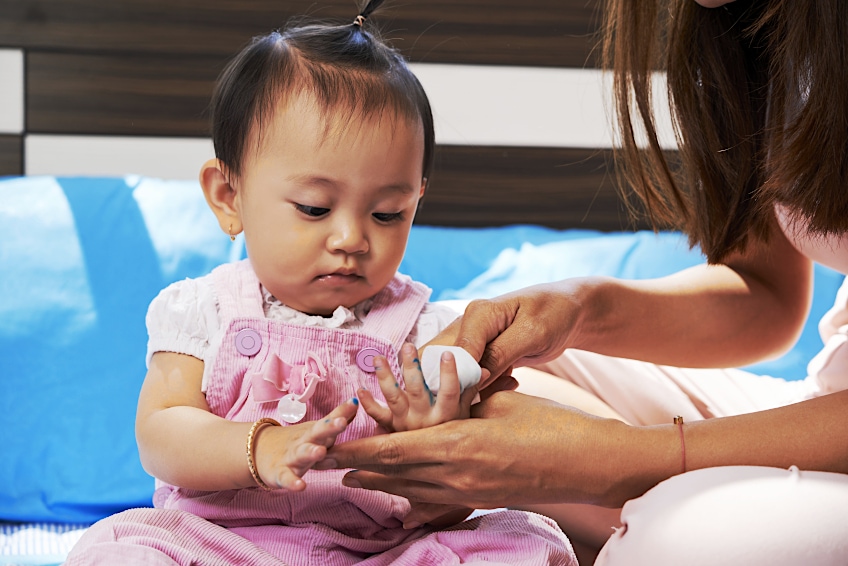
If you’re wondering how to remove acrylic paint from skin, the best advice is to try not to get any paint on yourself to begin with. Ideally, you should avoid getting large amounts of acrylic paint on your skin by working carefully and never applying it directly to your skin for any reason. If you have sensitive skin, you should consider working with gloves to avoid getting any paint on your hands while painting. If any acrylic paint does get on your skin, you should get it off as soon as possible because as it dries it will become a more challenging process.
What Paints Are Safe for Use on Skin?
What paints are safe for use on skin if you shouldn’t use acrylics? There are plenty of paints available on the market that are safe for use on skin as body paint or for creating hand/feet prints. Below we have compiled a list of the most popular paints available for different purposes and explained their benefits and downsides.

Water-Based Body Paint
Water-based body paints are regulated and follow strict safety guidelines. They emit less volatile organic compounds and contain no toxic ingredients. Overall, they are the safest paints available for use on skin but they tend to crack and rub off easily, which can make a mess and look unappealing.

Metallic Body Paint
Metallic body paint will produce a shiny finish that resembles metal. These body paints are more likely to cause some irritation however since they have real metal powder mixed in to create the metallic effect. If you use this sort of body paint you should make sure to read the manufacturer’s instructions and safety precautions before you get started.

Alcohol-Based Body Paint
Alcohol-based body paint is most commonly used in special effects. This kind of paint is waterproof and doesn’t crack but it may be prone to rubbing off. Alcohol-based paint is great for use in hot weather since it doesn’t budge due to sweat or humidity. The presence of alcohol in these paints helps it dry very quickly but its waterproof nature means that you will need makeup remover, baby oil, or liquid soap when you want to remove it from your skin. Be careful not to irritate your skin as you try to remove this kind of paint, as excessive rubbing could cause pain and inflammation.

Latex Body Paint
Liquid latex is a popular body paint choice that doesn’t crack peel or leave any residue. If you want to try this type of body paint you should first make sure you do not have a latex allergy and that you will not be using it in extreme heat. The paint is easy to remove using just warm soapy water and some light scrubbing.

Face Paint
Some amateur face painters may be seen painting faces with acrylics but this is very risky and ill-advised. Face paint isn’t really paint and is actually a very pigmented makeup. Face paint comes in a wide variety of colors and can be composed of powders, gum, or glycerin. Face paint is completely safe for use on skin and comes in a variety of different finishes. This kind of paint is a popular choice for people looking to use paint on skin and is probably the most well-known and readily available body paint on the market.

Henna
Henna is a traditional body paint that is made from plant dye that stains the skin a red, brown, or black shade that will fade over time. You can exfoliate the skin to speed up the fading process. Most henna is safe for adults and children but certain black henna variants contain para-phenylenediamine (PPD). PDD can cause skin irritation in some individuals, which can vary from tingling and itching to redness and blistering.

Washable Activity Paint
Washable activity paint is a popular choice for people looking for skin-safe paints to use in crafts. This finger paint is commonly used to create prints of a baby’s hands and feet because it is water-based, completely non-toxic, easily washed off of skin, and does not cause allergic reactions or irritation.
Acrylic paint might seem like it would make a great body paint but there are many reasons why that just isn’t the case. If you have been wondering how to make skin color with acrylic paint then hopefully, we have convinced you that even non-toxic acrylic paints should not be used on skin. Keep in mind that it is always better to be safe than sorry regarding the chemicals you work with while painting and crafting. Remember to always read safety information thoroughly before you get started with any new product and be especially careful if you have any children, toddlers, or pets running around. If you plan on painting onto skin, you should consider investing in some of the alternatives that we have mentioned in our article that will not cause any irritation. This way you can enjoy your project without the worry of breaking out in hives or blisters!
Frequently Asked Questions
Is Acrylic Paint Toxic if Swallowed?
You should not ingest acrylic paint even if the label says that it is non-toxic. Do not leave acrylic paint within reach of young children who could accidentally put it in their mouth. If your children are too young to understand not to put things into their mouths, you should not let them use acrylic paint. If you have older children that do not haphazardly put objects into their mouths, they should be able to use acrylic paints safely, but do not leave them unattended for prolonged periods.
What to Do if Acrylic Paint Is Swallowed?
Make sure that you read the manufacturer’s instructions when you purchase the paint so that you know what to do if you or someone else ingests any of the paint. If you are unsure or the instructions are unclear, you should phone poison control or your family physician and follow their instructions. A general rule of thumb to follow is that if someone ingests an amount of paint larger than their fingernail, they should contact medical professionals for guidance and assistance.
Is Acrylic Paint Safe for Babies and Children?
Toddlers shouldn’t be allowed to use any acrylic paint, even if it is labeled as non-toxic. If you want to put acrylic paint onto a toddler’s hands or feet to take a print, you should first perform a spot test on their skin using non-toxic paint. Apply a small amount of paint to your babies’ hands or feet and leave it there for a while. Be sure to rinse it off with warm soapy water before it dries and then wait a day before proceeding to take the prints. Older children can use acrylic paints but should be made aware of the precautions and kept supervised at all times.
How to Remove Acrylic Paint From a Baby’s Skin?
You should be able to remove wet or semi-dried acrylic paint from a baby’s skin using warm water and soap. If the paint has already dried you must avoid using anything too harsh or abrasive to try to remove the paint. Soak the skin in warm soapy water and then try to gently rub and lift the paint off. If this still doesn’t remove the paint you can also massage baby oil, coconut oil, or petroleum jelly onto the paint and surrounding skin to loosen the paint. Never use rubbing alcohol or rough scrubbers to remove dried acrylic paint off of a baby’s skin.
Can You Put Acrylic Paint on Your Face?
You shouldn’t apply acrylic paint directly onto the skin of the face. Even non-toxic acrylic paint can cause irritation and allergic reactions when put on skin. If acrylic paint dries on skin, it also becomes very hard to remove, and having to rub it off could cause harm. Painting faces with acrylics is not something you should do.
Larissa Meyer is a 32-year-old mother from Michigan and creative spirit since childhood. Her passion for painting and drawing has led her to an education as an illustrator and a career as a freelance graphic designer. She has a Bachelor of Fine Arts in Illustration and a degree in Graphic Design. Larissa is a talented artist who is able to master a wide range of styles and techniques to bring her artistic vision to life. Her greatest passion is currently fluid painting and epoxy resin art. Larissa’s love for art and her knowledge and experience in illustration make her the perfect Creative Director for our fluid-painting.com team. She is the creative head of our team and shares her passion and knowledge with our community through articles and tutorials.
As a mother of a 2-year-old daughter, Larissa also understands the importance of fostering creativity in early childhood. She uses her experience and knowledge to help other parents inspire their children and develop their artistic skills as well.
Learn more about Larissa Meyer and about us.

